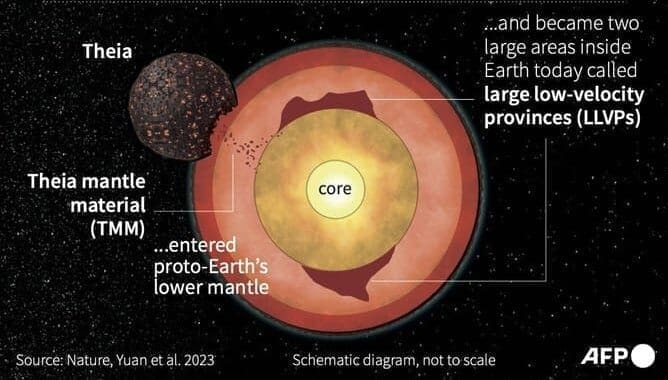Scientists have long known about two mysterious continent-sized blobs in the deepest part of Earth’s mantle, one under Africa and the other under the South Pacific region. Now, a new study published in the journal Nature suggests that these blobs may be relics from a cataclysmic collision between Earth and a Mars-sized object called Theia early in our planet’s history.

A view of Earth as seen by the Apollo 17 crew travelling toward the moon on December 7, 1972 – Source: REUTERS
This giant impact is thought to have blasted molten rock into space that eventually coalesced into the moon. But chunks of Theia may have also remained inside Earth, sinking to the core-mantle boundary, just above our planet’s scorching hot core.
The researchers used computer simulations to examine the impact event, the geophysical properties of Theia, and the evolution of Earth’s mantle. They found that most of Theia was absorbed into Earth, forming the two blobs, while the remaining debris formed the moon.
“The bottoms of these blobs are 2,900 kilometers below our feet,” said lead author Qian Yuan, a geophysicist at Caltech. “The two blobs are about 2% of Earth’s mass. Each of the blobs are twice the mass of the whole moon.”
If the study’s conclusions are correct, these blobs would represent the first concrete evidence of the moon-forming collision on Earth.
“There hasn’t been much consensus on whether we can find evidence for this event not just in the moon but also in some observable property of the modern Earth,” said co-author Paul Asimow, a geology and geochemistry professor at Caltech.
The two blobs are the largest deviations from a simple layered planet structure in Earth’s interior. The researchers believe that their increased density arises from their high level of iron, much like moon rocks.
“After the impact, these impactor materials would sink down to the core-mantle boundary because they likely have higher density than ambient mantle,” Yuan said.
The researchers say that future lunar missions could test their hypothesis by looking for isotopes and trace elements in lunar mantle rocks that are similar to those found in volcanic rocks on Earth.
Gaining a better understanding of the hypothesized giant impact could provide insights into the evolution of Earth and other rocky planets in our solar system and beyond.
“Earth is still the only confirmed habitable planet, and we do not know why,” Yuan said. “This collision likely set the initial condition of Earth’s evolution. Studying its consequences may help us to figure out why Earth is different than other rocky planets.”



